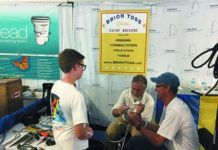Like a lot of sailboat owners all over the country, for me, the idle hours of late winter and early spring aren’t really idle at all. These pockets of time are dedicated to the chores of annual maintenance on board. Occasionally that can entail the odd upgrade or installation of new systems and gear. Lately, however, I’ve found myself primarily engaged in the business of remedying problems that shouldn’t have occurred in the first place.
Take deck openings, for instance. On my Trikala trimaran, there are no fewer than 10 inspection ports and three hatches-quite a few apertures for a 19-foot boat. Upon close examination of the aft-most hatch a few months back, I discovered that the bugger hadn’t been properly fastened. The dozen or so machine screws that kept it attached to the boat-along with a healthy dose of some adhesive-had simply been threaded into the deck. There were no nuts and no washers or backing plates on the underside.
This, I told myself, was an anomaly-a Friday afternoon oversight at the factory. So I rectified the situation by removing the fasteners, then the hatch, and finally, the adhesive residue. Then I rebedded the hatch using Sikaflex 291, and secured it with new stainless machine screws anchored with fender washers and nylock nuts. That, I reasoned, was how the job should have been done in the first place.
I suppose it shouldn’t have been surprising some time later to discover that none of the inspection ports on the boat had been properly fastened either. Each one had been bedded, and then simply attached either with machine screws or self-tapping screws. Granted, this isn’t an egregious offense. Inspection ports don’t normally endure a great deal of strain. But we all know that each one is an opening in the boat’s outer layer and thus exists as a potential entry point for moisture, which ultimately leads to material degradation. The torsion and flexion that every boat is subjected to mean that sooner or later a non-secured fastener will loosen and a seam will open up between the flange of the inspection port and the bedding or the bedding and the deck, and then you’ve got trouble.
All too often, we boat owners take it for granted that the products we buy-whether the actual boats or any manner of widget meant to serve aboard those boats-are flawlessly built and ready for our use. A steady succession of letters and e-mails sent to PS offices over the years-along with our own evaluations-indicates that this isn’t always so. Unfortunately, Friday afternoon glitches are sometimes more the rule than the exception.
Gladly, we’re reporting few such aberrations in the current issue, but in our May 15th edition, we’ll present another item for Gear Graveyard and we’ll examine a feature that’s noticeably absent on many offshore sailing craft-proper seaberths.
———-
In the meantime, I’d like to introduce two new PS contributors who surfaced via the ad we ran several months ago. Skip Allan of Capitola, CA, is a well-respected distance sailor who has both built and designed boats professionally. He built his own 27-foot passagemaker, and sailed it solo to New Zealand and back, some 13,000 miles. This represents a small portion of the 225,000 sea miles he has accumulated while distinguishing himself as a cruiser and racer.
And Jerry Waldorf of Wilmington, NC, is a retired mechanical engineer who specialized in component and system testing in the nuclear power industry. He’s a certified diver, and owns and maintains a Whitby 42 ketch, which he’s doted on since 1987. We’re looking foward to working with both of them.
-Dan Dickison



































